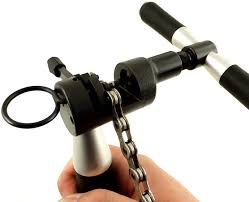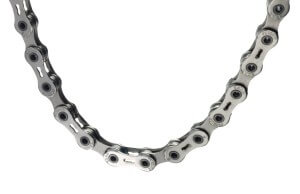Bicycle Chain Replacement
One of the most ignored regular maintenance items on a bike is the chain. Oh, we all know the chain needs to be lubricated regularly. That is not what I am talking about. What I mean is the regular replacement of the chain. The chain is comprised of literally hundreds of metal pieces that are rubbing together, and that combination of metal pieces is then rubbing against other metal pieces, i.e. the cassette and chainrings. The chain undergoes considerable stress and load, being heavily loaded and then unloaded as it returns to the rear derailleur, and all of this sometimes in a jerky fashion. It pulls against the sprockets of your cassette and the chainrings. It also has to undergo twisting forces en route from the cassette to the chainrings. This twisting is why cross-chaining is so discouraged, as it will wear your chain, and thus your cassette, more quickly.
If your bike is shifting fine, why would you want to replace your chain that is measuring as stretched? Having your chain replaced regularly will help your cassette last longer. Of course cassettes eventually wear out, but a worn out chain will more quickly wear out your cassette and chains are cheaper than cassettes. Most high end chains, such as a Campagnolo Record chain, are well under $100 and many are closer to $50. Meanwhile mid-level cassettes run $100+ while top of the line cassettes are often over $300 (some are over $600). An $85 chain is cheap insurance if you have a $655.00 cassette… Have that chain replaced in a timely manner if you want to save money while having your bike shift better in the process!
 The most common and easiest way to determine if a bicycle chain is in need of replacement is the use of a chain gauge, such as the Park Tool Chain Checker (which we carry at Fit Werx). A chain gauge measures chain “stretch”; more accurately it measures the wear in the holes where the pin engages the side plates of the chain. These holes gradually wear and, as the holes get bigger, the chain gets minutely longer. The Chain Checker measures this lengthening process, and is a very good indicator that a Shimano or SRAM chain needs to be replaced (Campagnolo says that their chains wear uniquely and chain checkers will thus not work).
The most common and easiest way to determine if a bicycle chain is in need of replacement is the use of a chain gauge, such as the Park Tool Chain Checker (which we carry at Fit Werx). A chain gauge measures chain “stretch”; more accurately it measures the wear in the holes where the pin engages the side plates of the chain. These holes gradually wear and, as the holes get bigger, the chain gets minutely longer. The Chain Checker measures this lengthening process, and is a very good indicator that a Shimano or SRAM chain needs to be replaced (Campagnolo says that their chains wear uniquely and chain checkers will thus not work).
What are some rule of thumb replacement parameters for bicycle chain replacement? For 10 and 11 speed drivetrains, assuming you have taken care of your chain, a good rule of thumb for all chains, Shimano, SRAM or Campagnolo, or other after-market chains, is to replace your chain approximately every 1,500 to 2,000 miles. Some riders and riding conditions are harder on chains than others, necessitating more frequent replacement, and failure to keep your chain lubed and clean will shorten its life, sometimes dramatically, as well. Older bikes equipped with 9, 8 or 7 speed chains can expect longer chain life, and these chains are more heavily built that the narrower more modern 10 and 11 speed chains. However, even for these older drivetrains, most chains should be replaced every 2,000 to 2,500 miles.
Care must be taken when replacing your chain as each chain brand and generation often has their own nuances. For example, Shimano 10 speed chains are directional – there is an inside and an outside. If you install the chain with the wrong side facing you, it will shift very poorly (Shimano eliminated directionality on their 11 speed chains). For Campagnolo chains, there is a specific orientation recommended by the manufacturer for maximum strength, as well as a recommended direction of installation for the chain pin (i.e. installed from inside to outside).
Likewise, care must also be taken in using the correct tools. Generally a chain tool that was manufactured for 10 speed chains will not work properly with the new 11 speed chains and vice-versa. Want to change your own Campy chain? You had better f ollow all of Campy’s directions meticulously, including peening over the pin, or else the chain will likely not hold together. Yes, you need special tools for this. A Campagnolo 11 speed chain tool is a marvelously engineered and constructed piece of equipment. However, costing over $220, it should work smooth as silk. Similarly, Shimano’s new 11 speed chain tool is not inexpensive either coming in around $170. Park Tools, and others, thankfully make reasonably good alternatives that are less expensive.
ollow all of Campy’s directions meticulously, including peening over the pin, or else the chain will likely not hold together. Yes, you need special tools for this. A Campagnolo 11 speed chain tool is a marvelously engineered and constructed piece of equipment. However, costing over $220, it should work smooth as silk. Similarly, Shimano’s new 11 speed chain tool is not inexpensive either coming in around $170. Park Tools, and others, thankfully make reasonably good alternatives that are less expensive.
If you have the correct tools, and plan to replace your chain yourself, you will notice that chains from the manufacturers usually come coated with gooey, thick, sticky lubricant that protects the unused chain against corrosion in transport. While you want to get this gooey lubricant off the outside of the chain (as it is sticky and will attract and hold dirt), do not soak your chain in a solvent to remove it. Many solvents wash the grease and lubricants out of the bushings, which will increase noise and wear. I just use regular chain lube for this purpose; it helps cleans off the excess goop, while allowing the lube that was on the chain to remain in the vital places, such as the bushings. Regular cleaning and/or use of a surface bio-degreaser will eventually get rid of all surface grease on the chain.
While replacing a chain is not really complicated, it is often best left to a bike shop that has the correct tools and knowledge for the job. Cut the chain too short and you could have potentially catastrophic results, such as ripping the rear derailleur off the bike Too long and the bike will shift badly. You could cut the new chain to match the length of the old one, but that assumes that the old one was cut to the proper length, not always a safe bet. Consider having your chain checked/replaced during your annual tune-up to simplify matters and you will never have to worry about it. Let me get my hands filthy…
Fit Werx, voted “America’s Best Bike Shop”, carries a range of quality chains for 8-11 speed drivetrains. Fit Werx has bike shop and fitting locations outside of NYC in Ridgefield Park, NJ, in Peabody and Lexington, MA and near Burlington, VT and Stowe, VT in Waitsfield. Fit Werx is changing the way people buy bicycles through their Rider First Bike Fittings and Rider Matched approach to bike sales. Don’t gamble on your next bike or your fit! Contact us for more information.


